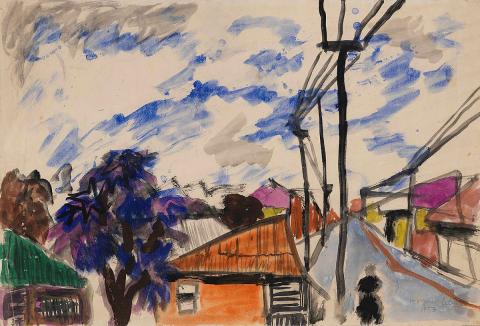Margaret Cilento: House at Annerley Junction
By Sally Stewart Joanna Bosse
February 1999
Margaret Cilento was born in Sydney in 1923. She travelled with her family in the first years of her life to Papua New Guinea before settling in Brisbane in 1928. Around the mid- to late 1930s Cilento studied at Sommerville House and the Central Technical College in Brisbane while attending art classes run by Caroline Barker. In 1940 she studied drawing under FJ Martyn Roberts in Brisbane before commencing study at the East Sydney Technical College in 1941. Here she studied painting under Douglas Dundas with fellow-student Margaret Olley.
After winning the Wattle League travelling scholarship in 1947, Cilento travelled to New York and joined her father who was working at the United Nations. She was one of the first Australian artists to choose to live in New York rather than Europe which enabled her to study at Atelier 17 under WS Hayter (where she was exposed to new print making techniques) and the Brooklyn Institute of Art and Sciences under Rufino Tamayo from 1947–49. During this time, she shared a studio in New York with fellow Australian artist Elaine Haxton and met Robert Motherwell, Barnett Newman and Joseph Albers through her attendance at The Subjects of the Artist School.
In 1950 Cilento moved to London and then to Paris, sharing an apartment with friends Margaret Olley and Anne Wienholt. The French Government awarded the artist a scholarship to attend the Academie des Beaux-Arts de l'Institut de France, which allowed her to remain in Paris and continue her art practice. At this time she also continued her studies at Atelier 17, after Hayter's relocation to Paris in 1950. Cilento returned to Brisbane in mid-1951 and commenced teaching at the Half Dozen Group of Artists studio at Kangaroo Point. Teaching became a large part of the artist's activities; she was employed at both the Stuartholme and Clayfield Colleges in Brisbane before moving to London and graduating from Goldsmiths College with an art teacher's certificate.
After teaching at various establishments including London County Council Schools, Cilento married in 1963 and returned to Australia to settle in Melbourne in 1965. After the birth of her first child Cilento chose to devote herself to family duties and her career as an artist was put on hold. She died in Melbourne on 21 November 2006. Painted soon after Margaret Cilento's return to Australia in 1951 from studying in New York, London and Paris, the gouache House at Annerley Junction shows the influence of her exposure to the post-war international artistic climate. However, this influence is not manifested in explicit stylistic debts. The results of Cilento's studies overseas can be seen instead in the consolidation of the more radical ideas of the abstract expressionists (concerning art as a means of self-extension and its reduction to gesture and colour) together with Cilento's own established preference for recording her visual surroundings. Line and form is very fluid and relaxed in this work. Cilento's account of urban landscape structures has been expressed through an abstract interpretation of them, as detail is not a primary concern.
Above all, this work shows Cilento's interest in and commitment to the depiction of the physical environment in terms of her emotional response. The use of the medium of gouache enables the direct translation of the artist's immediate emotional response into her mark making. In the catalogue for the 1981 retrospective exhibition, Nancy Underhill wrote of Cilento's work in the period after her studies abroad:
The forms stayed large, bulky, and third dimensional, the colours immediate but their use dualistic; at times it was to articulate forms and other times to engender emotional response . . . The work may be unresolved but it is open, honest and never half-hearted, tricky or just pretty.1
Many artists of the period in Brisbane were engaged in finding visual form for their surroundings. This study, along with the study for Street in Spring Hill are amongst the boldest yet most faithful accounts of these familiar Brisbane street environments.2
Joanna Bosse, former Curatorial Assistant, Australian Art, QAGOMA, February 1999; updated by Sally Stewart, former Curatorial Volunteer, Australian Art, September 2019.
Endnnote
- Nancy Underhill, Margaret Cilento, University of Queensland, Brisbane, 1981, p.10.
- On a visit to the Queensland Art Gallery on 18 May 2007, David Cilento, the artist's brother, advised that the house depicted in this painting belonged to the Jewell family and was situated in Villa Street, very close to the Cilento family home. (Glenn R Cooke, former Research Curator, Queensland Heritage, 18 May 2007.)
Connected objects
Related artists
CILENTO, Margaret
1923
- 2006
Full profile
for CILENTO, Margaret
Metadata, copyright and sharing information
About this story
- Subject


